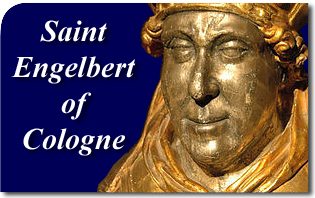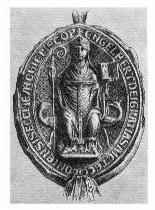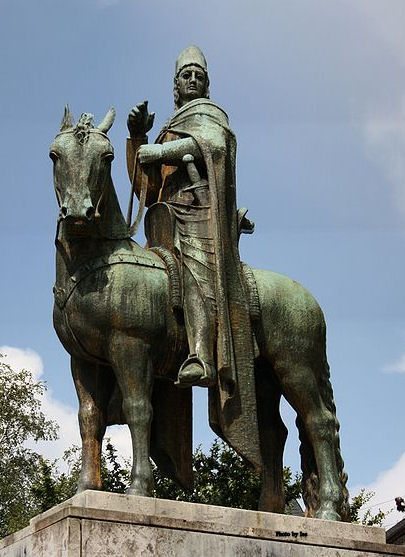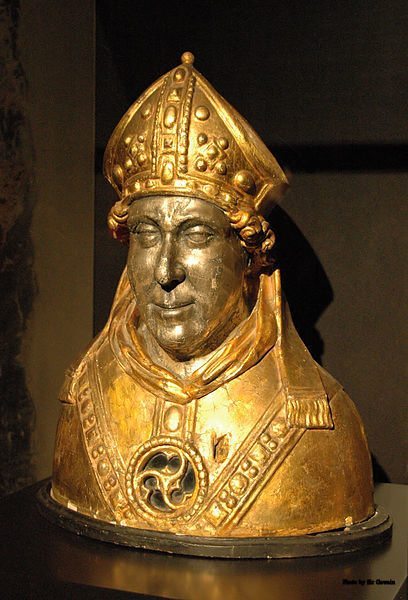 Archbishop of that city from 1216 – 1225, Saint Engelbert was born at Berg about 1185, and died near Schwelm on November 7, 1225. His father was Engelbert, Count of Berg, and his mother, Margaret, was daughter of the Count of Gelderland. He studied at the cathedral school of Cologne and while still a boy was, according to an abuse of that time, made provost of the churches of Saint George and Saint Severin at Cologne, and of Saint Mary’s at Aachen. In 1199 he was elected provost of the cathedral at Cologne.
Archbishop of that city from 1216 – 1225, Saint Engelbert was born at Berg about 1185, and died near Schwelm on November 7, 1225. His father was Engelbert, Count of Berg, and his mother, Margaret, was daughter of the Count of Gelderland. He studied at the cathedral school of Cologne and while still a boy was, according to an abuse of that time, made provost of the churches of Saint George and Saint Severin at Cologne, and of Saint Mary’s at Aachen. In 1199 he was elected provost of the cathedral at Cologne.
Engelbert Joins the Crusade to Atone for his Sin
He led a worldly life and in the conflict between Archbishops Adolf and Bruno sided with his cousin Adolf, and waged war for him. He was in consequence excommunicated by the pope together with his cousin and deposed in 1206. After his submission he was reinstated in 1208 and, to atone for his sin, joined the crusade against the Albigenses in 1212.

Archbishop Seal.
Archbishop of Cologne
On February 29, 1216, the chapter of the cathedral elected him archbishop by a unanimous vote. In appearance he was tall and handsome. He possessed a penetrating mind and keen discernment, was kind and condescending and loved justice and peace, but he was also ambitious and self willed. His archiepiscopal see had passed through severe struggles and suffered heavily, and he worked strenuously to repair the damage and to restore order. He took care of its possessions and revenues and was on that account compelled to resort to arms. He defeated the Duke of Limburg and the Count of Cleves and defended against them also the countship of Berg, which he had inherited in 1218 on the death of his brother. He restrained the impetuous citizens of Cologne, broke the stubbornness of the nobility, and erected strongholds for the defense of his territories. He did not spare even his own relations when guilty. In this way he gained the universal veneration of his people and increased the number of his vassals from year to year.
Although in exterior bearing a sovereign rather than a bishop, for which he was blamed by pious persons, he did not disregard his duties to the Church, but strove to uplift the religious life of his people. The mendicant orders which had been founded shortly before his accession, settled in Cologne during his administration, the Franciscans in 1219, the Dominicans in 1221. He was well disposed towards the monasteries and insisted on strict religious observance in them. Ecclesiastical affairs were regulated in provincial synods. Blameless in his own life, he was a friend of the clergy and a helper of the poor.

at Schloss Burg in Solingen.
Guardian of the King,
Administrator of the Empire
In the affairs of the empire Archbishop Engelbert exerted a strong influence. Emperor Frederick II, who had taken up his residence permanently in Sicily, gave Germany to his son, Henry VII, then still a minor, and in 1221 appointed Engelbert guardian of the king and administrator of the empire.
When the young king reached the age of twelve he was crowned at Aachen on May 8, 1222 by Archbishop Engelbert, who loved him as his own son and honored him as his sovereign. He watched over the king’s education and governed the empire in his name, careful above all to secure peace both within and without the realm.
At the Diet of Nordhausen (September 24, 1223) he made an important treaty with Denmark; in the rupture between England and France he sided with England and broke off relations with France. The poet Walther von der Vogelweide extols him as “Master of sovereigns,” and “True guardian of the king, thy exalted traits do honor to our emperor; chancellor whose like has never been.”
Devotion, Obedience and Martyrdom
Archbishop Engelbert’s devotion to duty, and his obedience to the pope and to the emperor were eventually the cause of his ruin. Many of the nobility feared rather than loved him, and he was obliged to surround himself with a bodyguard. The greatest danger threatened him from among his relatives. His cousin, Count Frederick of Isenberg, the secular administrator for the nuns of Essen, had grievously oppressed that abbey. Honorius III and the emperor urged Engelbert to protect the nuns in their rights. Count Frederick wished to forestall the archbishop, and his wife incited him to murder. Even his two brothers, the Bishops of Münster and Osnabrück, were suspected as privy to the matter.
Engelbert was warned, commended himself to the protection of Divine Providence, and amid tears made a confession of his whole life to the Bishop of Minden. On November 7, 1225, as he was journeying from Soest to Schwelm to consecrate a church, he was attacked on a dark evening by Frederick and his associates in a narrow defile, was wounded in the thigh, torn from his horse and killed. His body was covered with forty-seven wounds. It was placed on a dung-cart and brought to Cologne on the fourth day. King Henry wept bitterly over the remains, put the murderer under the ban of the empire, and saw him broken on the wheel a year later at Cologne.

He died contrite, having acknowledged and confessed his guilt. His associates also perished miserably within a short time. The crime, moreover, was disastrous for the German Empire, for the young king had now lost his best adviser and soon met a very sad fate, to the misfortune of his house and country.
Sainthood
Archbishop Engelbert, by his martyrdom made amends for his human weaknesses. His body was placed in the old cathedral of Cologne on February 24, 1226, by Cardinal Conrad von Urach. The latter also declared him a martyr; a formal canonization did not take place. In 1618 Archbishop Ferdinand ordered that his feast be celebrated on November 7th and solemnly raised his remains in 1622. In the martyrology Engelbert is commemorated on November 7th, as a martyr. A convent for nuns was erected at the place of his death. By order of Engelbert’s successor, Henry I, Cæsarius of Heisterbach, who possessed good information and a ready pen, wrote in 1226 the life of the saint in two books and added a third about his miracles.
Taken from The Catholic Encyclopedia, New York, Robert Appleton Company, 1909, Vol. V, pp. 429-430.

